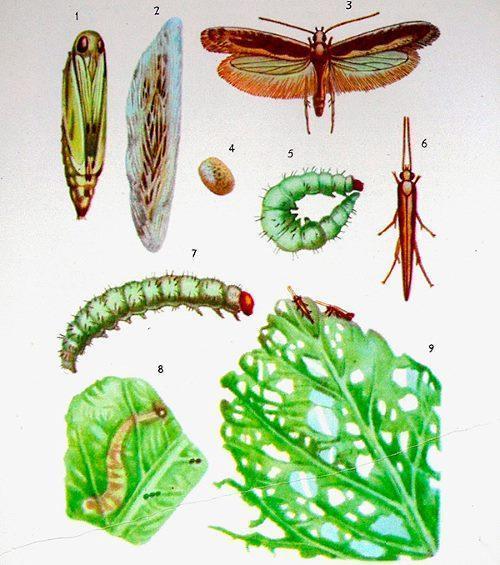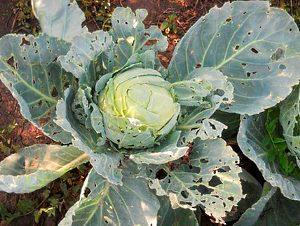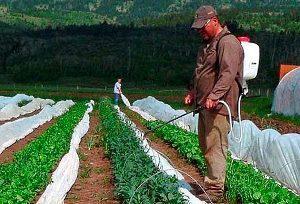Cabbage moth - measures to combat it
Summer in the country is associated not only with delicious berries, fruits and vegetables, but also with the struggle for a good harvest. If it is not too difficult to grow an early variety of cabbage, then later varieties will have to be protected from various pests, and especially the cabbage moth. A small butterfly lives throughout our country. She also reached the northern latitudes - the Kola Peninsula and Karelia. Summer residents of the southern regions feel especially harm from cabbage moth in their beds. To achieve good results in the fight against a small pest, it is necessary to study information about the insect itself and its habits, and use complex methods of control.
Cabbage moth and its lifestyle
It is very difficult to find a pest on cabbage beds before visible damage to the leaves of the plant. An inconspicuous grayish to brownish butterfly lives only 30 days. During this period, she is able to lay up to 300 eggs on the bottom of the cabbage leaf. In 72 hours after laying, the larvae hatch. Small, fusiform, yellowish caterpillars are born. Growing up, they change color to a light green color. This is clearly seen in the photo of the cabbage moth.

1 - pupa, 2 - cocoon, 3, 6 - butterfly, 4 - egg, 5, 7 - caterpillar, 8 - eggs on a cabbage leaf, 9 - damaged leaf
After 1–2 weeks, the grown eaters pupate and already in the cocoon the pupae develop to give birth to a new butterfly. The life cycle can be from 2 to 7 weeks. The air temperature has the main influence on its duration.
Important! At an air temperature of less than 8 degrees Celsius, adult cabbage moths and laid eggs die. To stop the development of larvae, a temperature of +5 and below is needed. At +9 Celsius, pupae development stops, but they survive and are able to survive the winter.
As soon as the air warms up to +10 and above, the years of the overwintered butterfly begins. In the southern regions, the summer period begins in early April and ends in late autumn. In the northern regions, the cabbage moth begins to fly from mid-June.
How and what does the cabbage moth damage?

Voracious larvae eat stems, strings and leaves. The caterpillars born first of all gnaw through the upper layer of the leaf and climb inside. There they remain until a certain age. An adult caterpillar crawls out onto the leaf surface and continues to feed on it.
Signs of the appearance of a cabbage moth on the site:
- Stopping the development of cabbage heads.
- The presence of holes in the cut heads of cabbage.
- The upper leaves are damaged, there are windows and grooves. On plants, nibbled buds.
- The outer leaves become pale and dry out.
- Caterpillars are crawling on the plants.
Only using all the methods of dealing with cabbage moth can you achieve a good result and keep the harvest of vegetables in your beds.
Complex control of cabbage moth is the key to success
A small nondescript butterfly is not capable of making long-distance flights on its own. It rises only 2 m above the ground. Emigration from site to site occurs due to gusts of wind.Pest control is conducted all year round, using its own methods and means for each season.
Important! The task of every summer resident is not to allow the cabbage moth to multiply in their beds.
Cleanliness of the site and surrounding areas
- After the vegetables are completely removed from the beds, it is necessary to start removing plant residues from the site. It is in them that pupae, carefully wrapped in cobwebs, winter. The collected garbage is burned, and small organic residues are plowed up.
- As soon as grasses and weeds begin to grow around the site in spring, take the scythe in your hands. The first butterflies fly out during the period when the beds are still being prepared or the first vegetables are being planted. They choose wild plants for their development and reproduction.
- The cabbage moth has its natural enemies. In the country, they can become real helpers in the fight against vegetable eaters. Do not kill toads, frogs, birds and lizards.
- Amazing parasitic insects like to feed on the larvae or eggs of the cabbage moth. To attract diadromus, trichogramma, apanteles, nitobia to your beds, grow clover, parsley, dill, bow, carrot, cilantro, mustard.
- As soon as you see eggs on the leaves, do foliar feeding superphosphate with potassium chloride. After 3 weeks, repeat the procedure for increasing the resistance of vegetables to pests.
The situation becomes more complicated when 15% of plants are affected and up to 5 caterpillars are found on one root. In hot summers and when the critical level is exceeded, it is necessary to carry out insecticide treatment. Without a powerful blow to the butterfly and larvae, saving a good harvest will not work.
Chemicals in the fight against cabbage moth
 Many summer residents ask how to deal with cabbage moth without using chemicals? It is almost impossible to save a crop with a strong pest infestation without the use of chemicals. Only young larvae and butterflies are exposed to the drugs, which will require several treatments of the site for complete destruction.
Many summer residents ask how to deal with cabbage moth without using chemicals? It is almost impossible to save a crop with a strong pest infestation without the use of chemicals. Only young larvae and butterflies are exposed to the drugs, which will require several treatments of the site for complete destruction.
Important! Before using chemicals, you should carefully study the instructions and protect the respiratory system.
Insecticides used to control the cabbage moth:
- Nurell.
- Karbofos.
- Talkord.
- Sodium fluorosilicate.
- Ripcord.
- Ambush and actellic.
Bacterial agents for fighting cabbage moth
 Preparations are made from toxins and bacterial spores. Best used when larvae are active. The advantage of treatment with bacterial agents lies in their non-toxicity and duration of exposure.
Preparations are made from toxins and bacterial spores. Best used when larvae are active. The advantage of treatment with bacterial agents lies in their non-toxicity and duration of exposure.
Most often, the beds are treated with solutions:
- Lepidocide.
- Entobacterin.
- Dipela.
- Bactospein.
- Dendrobacillin.
- Bitoxibacillin.
- Gomelin.
To treat the bottom of the leaves and the whole plant, you can prepare a tincture of dandelion leaves. For 10 liters of water add 500 g of crushed raw materials and a spoonful of liquid soap. Insist at least 3 hours.